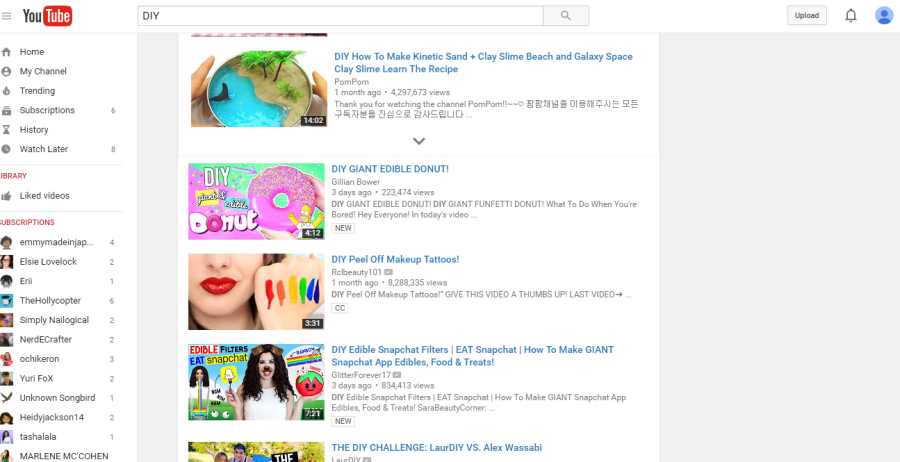One of the things I love most about DIY crafting is the sense of empowerment it gives me. I don’t have to rely on other people and companies to make things I can easily make myself. This gives me a lot of confidence and a sense of self-sufficiency. This kind of empowerment and creativity is something that everyone can benefit from, and yet there seems to be a stark lack of Black female representation in the online DIY community. As a Black female DIY crafters, I feel as if the DIY community values my white female counterparts more than people such as myself. When I want to take on a new DIY project, the first place I go is YouTube, and more often than not the YouTubers with the most subscribers are white women in their early twenties, while their Black counterparts, who are taking on the same DIY projects, are significantly less recognized by the DIY community. Here is a screenshot of the YouTubers that came up when I searched “DIY” into the YouTube search bar.
 This is a screenshot of the very first page of search results YouTube gave me, which means that these projects and channels are the most popular. Clearly, if the thumbnails are any indication, there are no Black DIY-ers on the first page, so I scrolled through the search results until I found one.
This is a screenshot of the very first page of search results YouTube gave me, which means that these projects and channels are the most popular. Clearly, if the thumbnails are any indication, there are no Black DIY-ers on the first page, so I scrolled through the search results until I found one.

I finally found one Black DIY-er, but I had to scroll all the way to page six, which, to be honest, hardly anyone searching YouTube ever looks that far. But the fact that I could only find one Black DIY-er with just the broad keyword “DIY” in the search bar shows how lacking Black female representation is in the DIY online community. Why are almost all the other channel results are white women or white men? How does this lack of representation affect how we subconsciously view Black creativity?
But first, we should talk about why representation is so important. Olivia Heusinkveld wrote an article titled “Why Does Media Representation Matter?” for the online student magazine the Wake where she expresses the importance of diversity and representation of ethnicities, races, and sexualities in the media. While her argument is geared towards media such as films, it is applicable to every other media outlet such as the DIY crafting community. She says “without representation of all races, genders, sexes, sexualities, body types, etc., there are stories that we are missing. Without equal representation, there are people who are not feeling heard or seen. In a nation and world as diverse and complex as ours, the last thing we want is to lose the stories of a large portion of our people” (Heusinkveld). The same can be said for representation in the DIY community; the lack of diversity in popular crafting channels means that we are missing out on other people’s stories, creativity, and opinions, which for a community that is supposed to be inclusive and all about sharing is a huge problem.
Furthermore, this lack of representation is especially harmful for young people who are just becoming aware of and interacting with popular members of the DIY community. As Rebecca Brand says in her article “‘If she can’t see it, she can’t be it’ Why Media Representation Matters” for the Guardian,
My own professional attention has since shifted to younger viewers. Their developing minds are that little bit more unquestioning about what they see and hear on their screens. Or, of equal import, what they don’t see and hear…What message are we giving those impressionable minds about women? And how might we be cutting the ambitions of little girls short before they’ve even had the chance to develop properly? (Brand).
If a young Black woman were to suddenly immerse herself in the DIY community, she would quickly realize, most likely on a subconscious level, how there is little, if any, Black female presence in this community, which would lead her to believe that in order for her creativity to matter to the masses she would have to be a “pretty” White woman in her early twenties. This subconscious conditioning could impact that young girl for the rest of her life, and she grows up thinking that white women’s ideas, imagination, and creativity matter more than anyone else’s, and she would probably never contribute to the DIY community by, say, uploading videos of her projects on YouTube, sharing pictures of her work on Pinterest, or any other social media outlet because she would think “who cares about my opinion?.”
Diversity is quickly becoming an increasingly important issue to discuss as society becomes more aware and empathetic to the plight of underrepresented groups. Fixing the lack of diversity in the DIY community is not something that will happen overnight; it will take a conscious, collective effort of the DIY community as a whole to work together to solve this problem by first openly discussing the issue of representation in the DIY community. Popular DIY channels and websites should promote and support smaller, less popular crafting channels and websites that are run by people of color. The key to solving the problem of representation is mutual support, understanding, and respect for everyone’s creativity.
Works Cited
Huesinkveld, Olivia. “Why Does Media Representation Matter? – The Wake Magazine.” The Wake Magazine. 23 Mar. 2015. Web. 12 Apr. 2016.
Brand, Rebecca. “‘If She Can’t See It, She Can’t Be It’: Why Media Representation Matters.” The Guardian. Guardian News and Media, 12 Nov. 2013. Web. 12 Apr. 2016.
“YouTube Search Results for ‘DIY’ Page One” YouTube, 2016. Screenshot.
“YouTube Search Results for ‘DIY’ Page Six” YouTube, 2016. Screenshot.